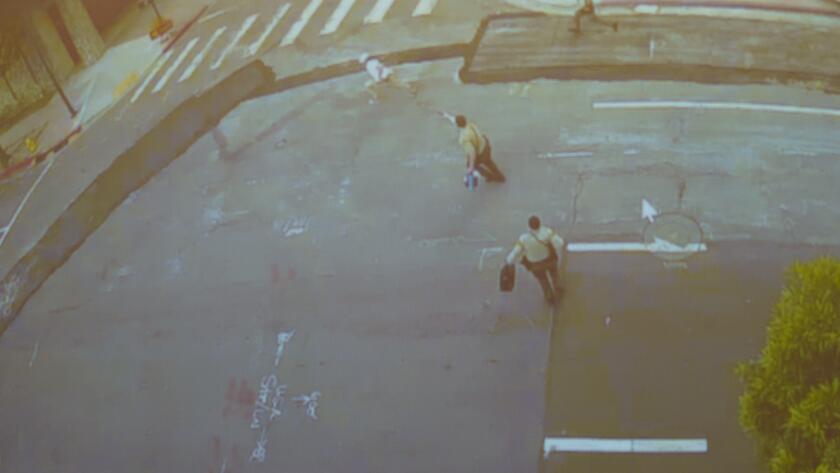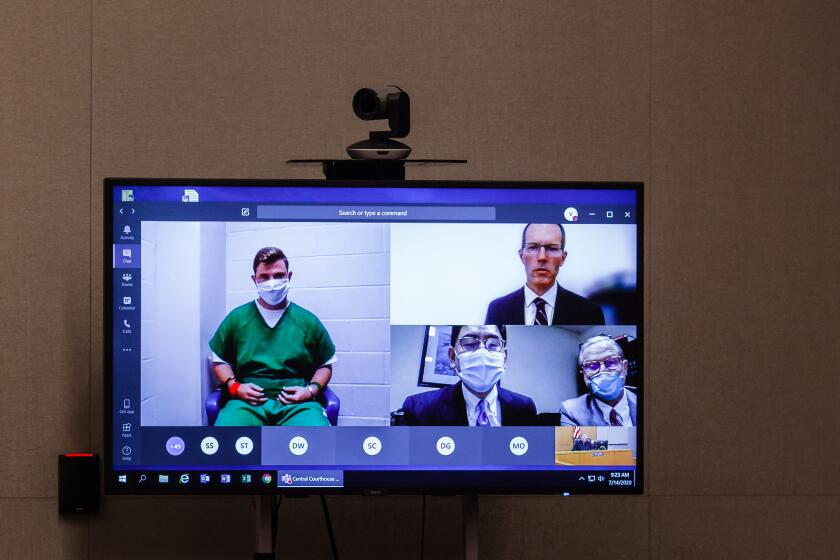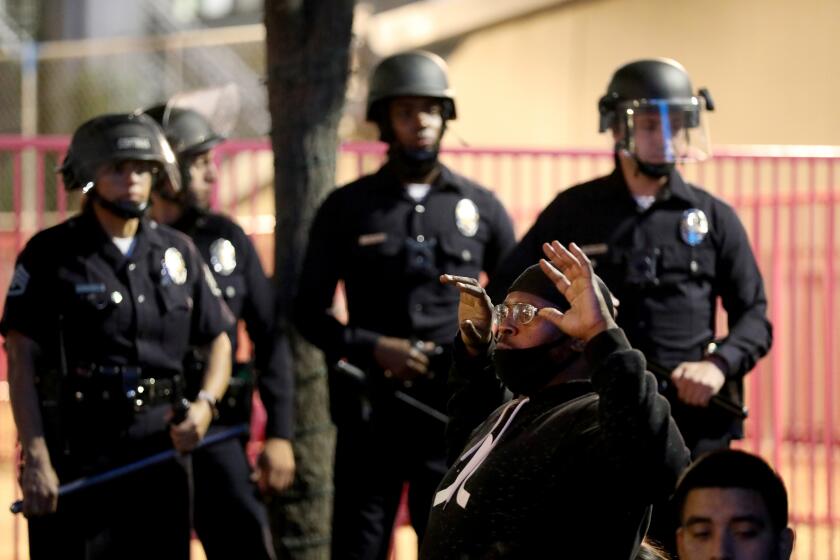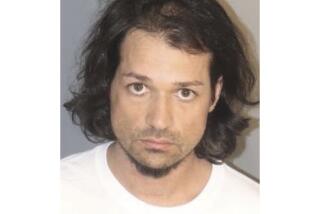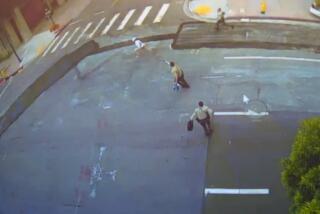Former San Diego County deputy faces trial on murder charge in death of fleeing detainee
Surveillance video from May 1, 2020 depicts a man escape from the back of a state park ranger’s patrol car in downtown San Diego, as well as the brief chase and fatal shooting that followed. Authorities said then-Deputy Aaron Russell saw the escape and fatally shot the fleeing man, identified as Nicholas Bils. The surveillance footage comes from a Smart Streetlight camera in downtown San Diego near the intersection of Front and B streets. The footage was played Tuesday in San Diego Superior Court during a preliminary hearing for Russell, who has pleaded not guilty to a charge of second-degree murder.
SAN DIEGO — A former San Diego County sheriff’s deputy must stand trial on a murder charge in the shooting death of a man he saw escape from a state parks patrol car near the downtown jail last spring, a judge ruled Wednesday.
Aaron Russell, 24, has pleaded not guilty in the death of Nicholas Bils, 36, who was shot as he sprinted away May 1. The shooting was caught on a surveillance camera on Smart Streetlights.
Superior Court Judge Theodore Weathers’ decision to order Russell to face trial came at the end of a preliminary hearing that spanned more than two days.
The new law changes the standard for when police can use deadly force from when ‘reasonable’ to prevent imminent, serious injury or death — to when ‘necessary.’
Russell is the first law enforcement officer in California to be charged with murder since the state raised the standard last year for when peace officers can use deadly force. The San Diego County district attorney’s office pointed to that law change in deciding to charge Russell.
Prosecutors contend Russell committed second-degree murder.
His defense attorney, Rick Pinckard, argued Wednesday that the use of force was justified. He said his client “perceived an imminent threat” from Bils, who was fleeing custody and running toward traffic stopped at the intersection.
“Is it reasonable for a deputy in that same situation to see the imminent threat of a possible carjacking, robbery, kidnapping, whatever — a violent act by a violent desperate escaping individual — is that reasonable?” Pinckard said. “The defense would submit that yes, it is.”
Weathers denied Pinckard’s request to dismiss the charge or to reduce it to voluntary manslaughter.
“The defendant has raised several theories of justification for the use of the force, but the court believes that these issues will have to be considered by the jury in this case,” Weathers said.
The judge pointed to testimony from Deputy Darrell Ross, who had been walking alongside Russell — the two were headed to work at the jail — when the shooting occurred.
Weathers said he found Ross’ testimony “most compelling.” He said that Ross and Russell presumably had similar training, and that Ross presumably made similar observations as Russell during the encounter.
Ross testified Tuesday that as they walked, the park ranger’s car approached the jail sally port. Ross saw an arm squeezed through a gap between bars on a backseat window.
He said he and Russell “looked at each other pretty much in disbelief.”
A bill to add tough penalties for police officers who do not intervene when witnessing a fellow officer use excessive force was sidelined in the California Legislature on Thursday. Assembly Bill 1022 by Assemblyman Chris Holden (D-Pasadena) would have made an officer an accessory to a crime if they were capable of stopping an incident of excessive force by another officer and failed to do so.
Bils — who had slipped his left hand out of a handcuff — fumbled for the door handle, according to the testimony. As the car reached the jail entrance, he broke out of the vehicle.
A nearby park ranger opened the door of his pickup and tried to get out to stop Bils, but Bils shoved the door against the ranger and took off running, handcuffs still on one wrist. The ranger ran after him.
As Bils ran, Russell fired five shots, striking Bils four times. The shots came from behind and to the left of Bils.
Ross testified Tuesday that he had intended to chase and tackle Bils, and said he “saw no need for any type of other force.” Ross said he had not felt that anyone was in danger and he did not pull his gun.
The judge also heard from the state parks ranger who’d been driving Bils to jail when he escaped, and from the second park ranger who chased Bils. Neither pulled their guns.
Deputy Dist. Atty. Stephen Marquardt argued that the shooting was not legally justified and noted that no other officers at the scene pulled a weapon.
“The idea that this amount of force was necessary ... it’s just not plausible,” Marquardt said.
In January 2020, California law changed to make use of deadly force permissible only when “necessary,” when a life is in imminent danger and nonlethal methods are not available. Previously, deadly force had been allowable when “reasonable.”
Russell’s attorney argued that none of the other officers saw exactly what Russell saw, including when Bils got out of the car.
“For a split second or however long it takes, Deputy Russell sees something from his perspective that nobody else sees,” Pinckard said. “We know that because he begins to draw his gun.”
The “reasonable inference is that [Russell] saw shiny metal,” likely the handcuff on Bils’ right hand, Pinckard said.
Russell, who is out of custody on bond, is due back in court next month, but no trial date is set.
Figueroa writes for the San Diego Union-Tribune.
More to Read
Sign up for Essential California
The most important California stories and recommendations in your inbox every morning.
You may occasionally receive promotional content from the Los Angeles Times.
